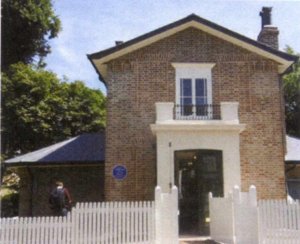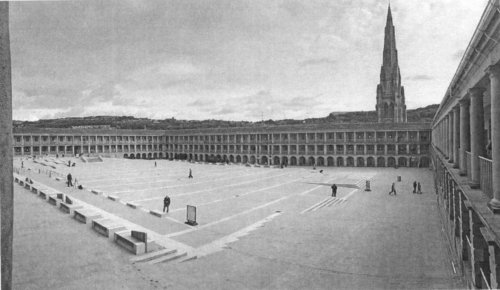Civic Voice Design Awards 2018 - TrustNews Sep 18
The presentation of the Awards was hosted by Rogers Stirk Harbour + Partners at their offices in the Leadenhall Building, City of London, on 12 July. This proved to be an impressive and apt venue and Civic Voice with Joan Humble, Chair, ensured an interesting, lively and instructive occasion for all attending.
Max Farrell was Chair of the Civic Voice Design Awards judging panel which comprised of Rob Cowan - Urban Design Skills; Russ Hamilton - Farrells; Louise Palomba - Rogers Stirk Harbour + Partners; Sophia de Sousa - Glass-House Community Led Design; John Walker - The Ramsgate Society.

Presentation Hall
The categories for nominations were Historic Buildings, Housing, New Build, Public Realm, and Conservation Area where Awards were given in each. The judges‘ comment accompanies my brief summary of each Award.
ln his address, Max Farrell posed this question which l think set the tone for this year's Award:
“ Engaging with the community to achieve high quality design? It seems such a strange thought for some. But, it is happening. The awards are an example of that. We hope we are enabling more communities to find their voice and ask:
‘lf they can have that, why can't we?’ As judges, we want to demonstrate that, with the right architect and the right imagination, high quality development can be achieved in partnership with the community. We want to see the right development in the right location. Not the wrong development in the wrong location.”
The Winner for Historic Buildings was Storyhouse, Chester. Nominated by Chester Civic Trust, this was originally a 1930s Art Deco Odeon Cinema and after years of neglect was transformed by Bennetts Associates to become a hive of activities to include a library, theatre, cinema and cultural centre in historic Chester.

Winner - Storyhouse
Storyhouse was also the Design Awards Overall Winner 2018.
Historic Buildings had a number of significant entries including our own nomination for the Treasury at Winchester College. The Treasury was short-listed which is, I was assured, no mean recognition of its worth. Two other buildings, however, were Highly Commended and deserve mention here.
Thames Lido, Reading, nominated by Reading Civic Society, was believed to be one of the oldest outdoor municipal pools of the Edwardian era built to allow women to bathe with privacy. It was closed in 1974 and after falling into disrepair, and a restoration campaign of nearly 20 years, it has become once again a stunning leisure complex for public use through the vision of Marshall & Kendon Architects.
"Thanks to local people, a long-fought campaign, and a sympathetic developer, Thames Lido has been saved. The careful and beautiful restoration sets an example to others, at a time when many local authorities are having to close swimming pools. The quality of this restoration shines through."

People's Award Winner -
Sandycombe Lodge
Sandycombe Lodge, Twickenham, is an early nineteenth century villa designed by the artist J.M.W. Turner as his rural retreat by the Thames. Initiated by the local community it has been restored by Butler Hegarty Architects to Turner's original vision of a small rustic building in a picturesque landscape.
“The quality of this little gem of a project is outstanding. Turner’s house has been lovingly restored and the attention to detail paid by the architect working in partnership with the Turner's House Trust and the Friends of Turner's House is exceptional. This is a project of national importance which, no doubt, would have pleased Turner himself".
This project also won The People’s Award.
The Housing Winner was St Clement's, Bow, London. Originally a former workhouse of the late 1840s onwards comprising of 19 buildings, it had been boarded up since 2005. A vigorous campaign by East Londoners eventually persuaded the Mayor of London to establish its first ever Community Land Trust in 2012. This was then to create a residential quarter for affordable housing and after extensive consultation was brought to fruition by JTP.
“This scheme is a pioneer in terms of community-led housing. Innovative in so many ways; from the affordable housing model itself, to the collaborative planning process and the creation of a piece of urbanism with life and soul. It is clear that the Community Land trust model is now a genuine method to help deliver the housing the nation needs.”
Nominated by London Community Land Trust.
The New Build Winner was the Enterprise Centre at the University of East Anglia, Norwich, created and built by Architype. Nominated by The Norwich Society as a flagship building because of its sustainability, innovative use of natural materials and environmental design, and, not least, its potential as a hub for entrepreneurs, innovators and businesses to be shared with the academic and student communities.
“It is encouraging to see a university leading the way in promoting a sustainable future and a route from education to employment for its students. An exceptional project, setting the standard for sustainable construction and innovation.”

New Build Winner -
Enterprise Centre,University of East Anglia
The Winner for Public Realm was for the Calverley Adventure Grounds, Tunbridge Wells. The site of a disused bowling green suffering from being an unwelcome focus for anti-social behaviour in the centre of Tunbridge Wells, was redesigned by Jennette Emery-Wallis to become an innovative children‘s playground. its principle was to encourage children to work together to develop social skills through play, using artistic references to the locale and natural materials that would also foster inter-generational play. This communal project is seen as a vital first step for regenerating their listed historic park.
“Calverley Adventure Grounds raises the bar in playground design and shows just what is possible with thought and imagination. Innovative play spaces are so rare in our communities, with standardised play equipment the norm. Calverley is the antithesis of this and is an exemplar for communities to be inspired by.”
Nominated by Tunbridge Wells Civic Society.
There were two Winners for the Conservation Area category:
1. Market Place, Cirencester, was nominated by Cirencester Civic Society. For over 40 years attempts had been made to solve the problem of their central market area which was being steadily killed off by ever-increasing traffic. Eventually the town council raised funds to implement the scheme designed by Portus + Whitton, landscape architects, whose design wove the space into the existing fabric of the town and its historic core, and now forms the ‘civic heart’ of Cirencester.
“We applaud Cirencester Town Council for taking the lead in tackling a dif?cult problem head on and reclaiming the historic centre of the town for people not cars. The Market Place scheme demonstrates the power of urban design in helping to enliven our historic high streets and sets an example for Conservation Areas across the country.”
2. Theatre Royal, York, was originally built in 1744 and has undergone many alterations and extensions over time creating a rich and fascinating past. However, all this had led to a desperate need for internal refurbishment not to mention the repair of its badly leaking roof. De Matos Ryan undertook sensitive de-cluttering and sympathetic interventions which have unified the patchwork of historic periods and helped to uncover further significant Roman and mediaeval archaeology that contribute much to York's rich history.
"This restoration has cleverly revealed the layers of time of both an important building and its setting from its Roman and medieval archaeology through to its celebrated twentieth century architecture. The project has opened the building to the street and positively enhanced the Conservation Area.”

Special Winner - The Piece Hall, Halifax
Max Farrell announced that the judges decided to bestow a Special Prize this year (only the second in the history of the Awards) to The Piece Hall, Halifax (above), nominated by Halifax Civic Trust, which they considered a truly stunning project supported by the Heritage Lottery Fund. The Piece Hall is a Grade 1 listed building dating from the 1770s and after it fell into disrepair the Calderdale Council embarked upon a major programme of restoration in 2009, engaging wide public participation through consultation to ensure the people of Halifax were central to the project. LDN Architects and Gillespies transformed this historic building and site to return the space to Halifax as a bold, dramatic and cleverly designed piece of public realm with new heritage spaces and a vast courtyard piazza containing new lighting, seating and water features with a capacity for 7,500.
“This council-initiated project really seems to do justice to this extraordinary historic building, turning it into an exceptional community asset. The Piece Hall is a unique asset for Halifax and now located at the hear! of the town's new Cultural Quarter which includes a previous Civic Voice Design Award winner, Orangebox Young People's Centre. This is not a coincidence and must surely be down to local leadership, something every successful project needs."
These important Awards bring most welcome notice of a tremendous variety of truly inspiring projects undertaken across the country. They go to show how communities can work together effectively with their local council, bringing vision and innovation into play thereby creating tremendous assets that enhance and contribute to the civic heart of a place. Such a shared approach engenders considerable civic pride but it clearly does require a sympathetic council prepared to listen, take advice, engage those members of the community who are able to give of their expertise, and whose agenda is open for the common good and not parti-pris in its approach to policy, and, importantly, where public consultation becomes more than a box-ticking exercise.
